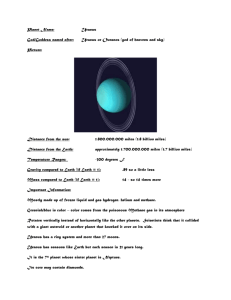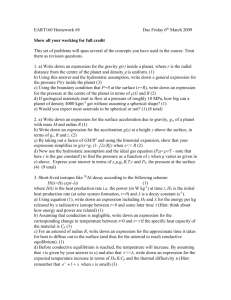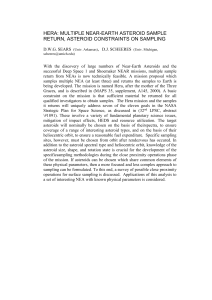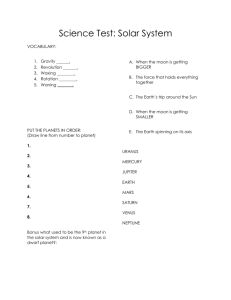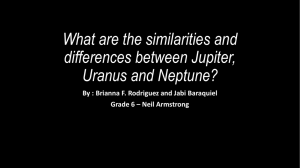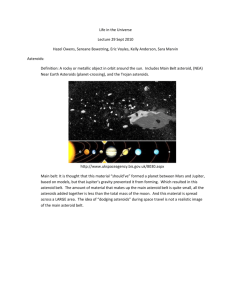PTYS/ASTR 206 – Section 2 – Fall 2004 Activity #1: 8/25/04
advertisement
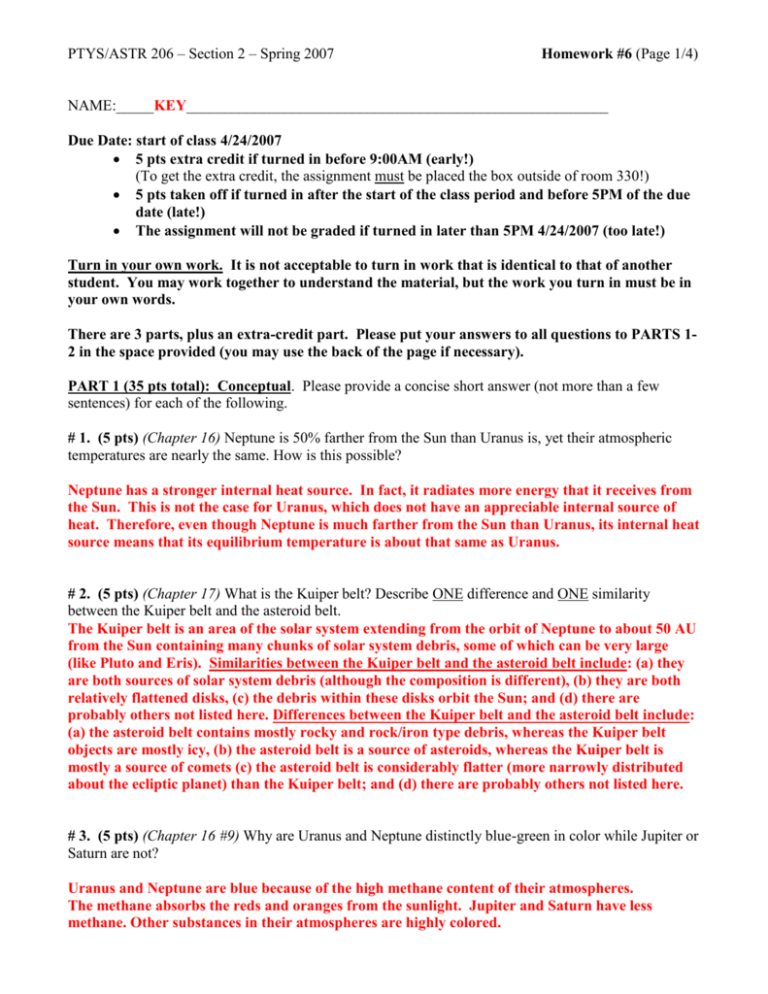
PTYS/ASTR 206 – Section 2 – Spring 2007 Homework #6 (Page 1/4) NAME:_____KEY________________________________________________________ Due Date: start of class 4/24/2007 5 pts extra credit if turned in before 9:00AM (early!) (To get the extra credit, the assignment must be placed the box outside of room 330!) 5 pts taken off if turned in after the start of the class period and before 5PM of the due date (late!) The assignment will not be graded if turned in later than 5PM 4/24/2007 (too late!) Turn in your own work. It is not acceptable to turn in work that is identical to that of another student. You may work together to understand the material, but the work you turn in must be in your own words. There are 3 parts, plus an extra-credit part. Please put your answers to all questions to PARTS 12 in the space provided (you may use the back of the page if necessary). PART 1 (35 pts total): Conceptual. Please provide a concise short answer (not more than a few sentences) for each of the following. # 1. (5 pts) (Chapter 16) Neptune is 50% farther from the Sun than Uranus is, yet their atmospheric temperatures are nearly the same. How is this possible? Neptune has a stronger internal heat source. In fact, it radiates more energy that it receives from the Sun. This is not the case for Uranus, which does not have an appreciable internal source of heat. Therefore, even though Neptune is much farther from the Sun than Uranus, its internal heat source means that its equilibrium temperature is about that same as Uranus. # 2. (5 pts) (Chapter 17) What is the Kuiper belt? Describe ONE difference and ONE similarity between the Kuiper belt and the asteroid belt. The Kuiper belt is an area of the solar system extending from the orbit of Neptune to about 50 AU from the Sun containing many chunks of solar system debris, some of which can be very large (like Pluto and Eris). Similarities between the Kuiper belt and the asteroid belt include: (a) they are both sources of solar system debris (although the composition is different), (b) they are both relatively flattened disks, (c) the debris within these disks orbit the Sun; and (d) there are probably others not listed here. Differences between the Kuiper belt and the asteroid belt include: (a) the asteroid belt contains mostly rocky and rock/iron type debris, whereas the Kuiper belt objects are mostly icy, (b) the asteroid belt is a source of asteroids, whereas the Kuiper belt is mostly a source of comets (c) the asteroid belt is considerably flatter (more narrowly distributed about the ecliptic planet) than the Kuiper belt; and (d) there are probably others not listed here. # 3. (5 pts) (Chapter 16 #9) Why are Uranus and Neptune distinctly blue-green in color while Jupiter or Saturn are not? Uranus and Neptune are blue because of the high methane content of their atmospheres. The methane absorbs the reds and oranges from the sunlight. Jupiter and Saturn have less methane. Other substances in their atmospheres are highly colored. PTYS/ASTR 206 – Section 2 – Spring 2007 Homework #6 (Page 2/4) # 4. (5 pts) (Chapter 16 #10) Why are fewer white clouds seen on Uranus and Neptune than on Jupiter and Saturn? White clouds are due to water and ammonia. These substances are frozen out of the atmospheres of Uranus and Neptune. # 5. (5 pts) (Chapter 17) Why do comets have prominent tails for only a short time during each orbit? Comets are mostly composed of icy and volatile materials. Thus, as a comet gets closer to the Sun, the volatiles are released (i.e. out-gassed) bringing lots of the dust with them. This dust reflects sunlight very well making the “tail” very prominent. However, when the comet is farther from the Sun, as it is most of the time, the volatiles remain locked into the comet and there is no tail. Also, comets have highly eccentric orbits, so they spend very little time near the Sun. Thus, their tails are only prominent for very short periods of time compared to their overall orbital period. #6. (5 pts) (Chapter 17, Question #14) Explain how scientist can determine that certain meteorites come from the interior of an asteroid rather than its surface. If differentiation occurred in an asteroid, then it would have an iron core and a rocky mantle. Iron meteorites are thought to come from the cores of shattered differentiated asteroids. Stony meteorites came from their mantles and stony-irons from the core-mantle boundary. #7. (5 pts) (Chapter 16) Using the definition of a planet as defined recently by the IAU (you can access the criteria on http://en.wikipedia.org/wiki/Definition_of_planet under the “IAU Debate” section about midway into the section), explain why Pluto is NOT a planet. Next, explain why Pluto could be considered a planet. According the IAU’s definition a planet is a celestial body that (a) orbits the Sun, (b) for its selfgravity to overcome rigid body forces so that it assumes a hydrostatic equilibrium (nearly round) shape, and (c) has cleared the neighborhood around its orbit. Pluto satisfies the first two of these, but not the third. The reason why it does not satisfy the third is because it occasionally moves inside the orbit of Neptune – so, it has not cleared its neighborhood of Neptune. Note that the IAU also defined a “dwarf planet”, which Pluto does satisfy. So, Pluto is actually considered a “dwarf planet” by the IAU’s new description. One reason why Pluto could be considered a planet is that it nearly all textbooks consider it a planet and it has been a planet for the past 75 years. Thus, one could consider it “grandfatheredin” as a planet. You may be more clever than me and come up with new definitions of a planet that would include Pluto but not the potentially huge number of other such objects that are bound to be discovered that would be impossible for schoolchildren to learn the names of! PTYS/ASTR 206 – Section 2 – Spring 2007 Homework #6 (Page 3/4) PART 2 (15 pts total): Quantitative # 1. (5 pts) (Chapter 16) A new asteroid has been discovered. This asteroid has a small secondary (about 1/10 the radius of the primary) that orbits every 1.5 days and has a semi-major axis of 100 km. What is the mass of the primary? We get the asteroids (primary) mass by noting its gravitational effect on the small secondary (or moon). Since this small object is orbiting the asteroid, we use Newton’s form of Kepler’s third law Note that in the last step, we assumed that the mass of the asteroid moon (secondary) is very small compared to that of the asteroid, so we can drop it from the above formula. Solving this for the Mass of the asteroid (simple algebra) and inserting numbers, we get # 2. (5 pts) (Chapter 17) Use the percentages of stones, irons and stony iron meteorites that fall to Earth to estimate what fraction of their parent asteroid’s interior volume consisted of an iron core. Assume that the percentages of stones and irons that fall to the Earth indicate the relative fractions of a parent asteroid’s interior occupied by rock and iron respectively. How valid do you think this assumption is? The approximate percentage of iron meteorites that have been found on Earth is about 5% by number, and the percentage of stony meteorites is about 94% (and about 1% stony-iron meteorites). Since these are the fractions by number, and if we assume that they either came from one differentiated parent asteroid (or, equivalently, assume that all asteroids are differentiated in the same way), then these fractions represent the fraction of the volume of the asteroid occupied by each type of material (iron, rock). However, this is clearly not a good assumption. There are many asteroids and only a few that are differentiated. Many asteroids are not differentiated at all. Also, there is probably a bias in the way they are collected. Iron meteorites are much easier to spot than stony meteorites because there is very little pure iron on the surface of the Earth that is not of meteoritic origin. Many stony meteorites may go unnoticed. PTYS/ASTR 206 – Section 2 – Spring 2007 Homework #6 (Page 4/4) # 3. (5 pts) (Chapter 16) The large Kuiper-belt object 90482 Orcus is like the planet Pluto in one important respect: it is a Plutino. A plutino is a trans-Neptunian object in 3:2 mean motion resonance with Neptune. a) 90482 Orcus has a semi-major axis of 39.42 AU. What is its orbital period (in years)? We use Kepler’s third law (the simpler version because we are dealing with an object in orbit about the Sun) to get P2 = a3 = (39.42)3 years2 giving P = 247.5 years b) Using your answer in part (b) and Neptune’s orbital period from Table 16-2 of the textbook, verify that 90482 Orcus is a Plutino. From Table 16-2 of the textbook, Neptune’s orbital period is 164.86 years. Therefore, it will take Neptune (3)(164.86) years = 494.6 years to complete 3 complete orbits. During the same time, 90482 Orcus would have completed 2 complete orbits because (2)(247.5) = 495 years. Thus, 90482 must be a Plutino. c) The recently discovered Kuiper-belt object (which some argue is the 10th planet) UB313 has a semi-major axis of 67.67 AU. Is it a Plutino? Justify your answer. Using Kepler’s third law again, we find that UB313 (now called Eris) has an orbital period of P2 = a3 = (67.67)3 years2 giving P = 556.7 years Hence, it will take UB313 (Eris) 1113.4 years to complete 2 orbits, and this is much different than the time it takes Neptune to complete 3 orbits. Hence, UB313 is NOT a plutino. Over for the extra credit solutions PART 4: Extra Credit Points available: 2 for one, 5 for both Please provide your answers on a separate sheet of paper and attach it to the rest of your homework. EC #1 (Chapter 16) Explain why Uranus’s satellites Caliban and Sycorax were probably captured from space instead of forming at the same time the planet itself formed. Both of these asteroids are in highly-inclined retrograde orbits around Uranus. This would not be possible if these objects formed at about the same time from the material near Uranus when it was also forming because the moons would then be orbiting about the equator of Uranus and in a prograde orbit. Since this is not the case, they are presumably captured asteroids. EC #2 Ch 17, Q. 42 An asteroid the size of Texas is bigger than the known asteroids. Blowing a larger asteroid into smaller pieces may simply result in many more but smaller impacts. Either way, it’s a bad deal.
